Subaru Outback (BR): Front Lateral Link
A: REMOVAL
1) Lift up the vehicle, and then remove the rear wheels.
2) Remove the trailing link.
- Remove the bracket, and remove the parking brake cable from the guide (a).
- Remove the bolts and nuts, and then remove the trailing link.
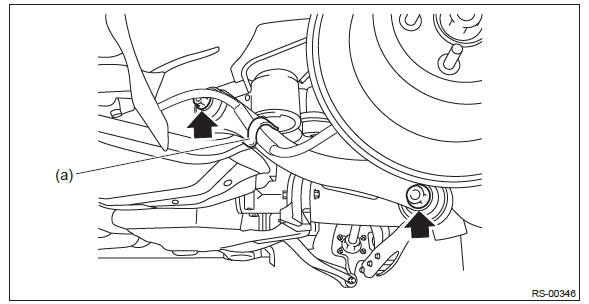
3) Remove the front lateral link.
- Remove the snap pin (a) and nut (b).
- Using a puller, remove the ball joint.
PREPARATION TOOL: Tie-rod end puller
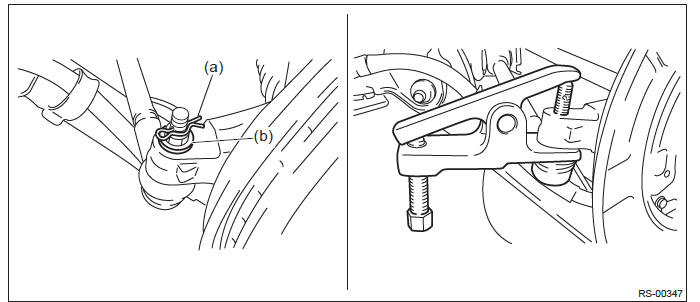
- Scribe an alignment mark on the front lateral link adjusting bolt and rear sub frame.
- Remove the adjusting bolt, and remove the front lateral link.
CAUTION: When removing the adjusting bolt, make sure to fix the bolt head in place when loosening the nut.
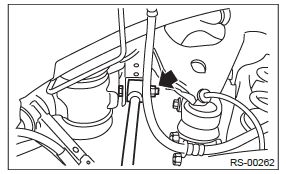
B: INSTALLATION
CAUTION:
- Be sure to use a new self-locking nut.
- Always tighten the bushing in the state where the vehicle is at curb weight and the wheels are in full contact with the ground.
1) Before installation, inspect the following items and replace any faulty part with a new one.
- Visually check the front lateral link for damage and deformation.
- Visually check the bushing for abnormal cracks, fatigue or damage.
- Visually check the dust cover on the ball joint for abnormal cracks, fatigue or damage.
2) Install each part in the reverse order of removal.
Tightening torque:
Front lateral link - sub frame: 120 N*m (12.24 kgf-m, 88.5 ft-lb)
Front lateral link - rear axle housing: 60 N*m (6.12 kgf-m, 44.3 ft-lb)
3) Inspect the wheel alignment and adjust if necessary. <Ref. to FS-9, INSPECTION, Wheel Alignment.>
C: DISASSEMBLY
Using the ST, push out the bushing.
PREPARATION TOOL: ST-A & ST-B: INSTALLER & REMOVER (20299AE000)
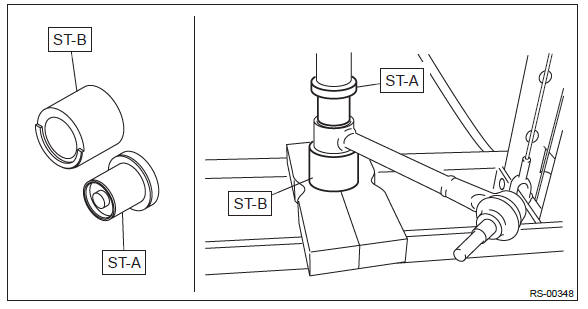
D: ASSEMBLY
1) Before assembly, inspect the following items and replace any faulty part with a new one.
- Visually check the front lateral link for damage and deformation.
- Visually check the bushing for abnormal cracks, fatigue or damage.
- Visually check the dust cover on the ball joint for damage.
2) Using the ST, press the bushing into place.
CAUTION: Make sure to press the bushing straight in.
PREPARATION TOOL: ST-A & ST-B: INSTALLER & REMOVER (20299AE000)
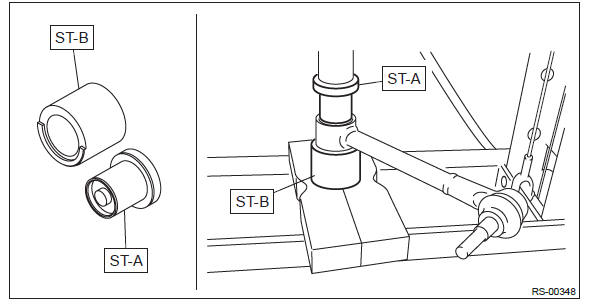
Rear Lateral Link
A: REMOVAL
1) Lift up the vehicle, and then remove the rear wheels.
2) Remove the bolts and nuts and lower the rear lateral link.
- Remove the nut and disconnect the rear stabilizer link.
- Remove the shock absorber lower bolt.
- Disconnect the rear lateral link.
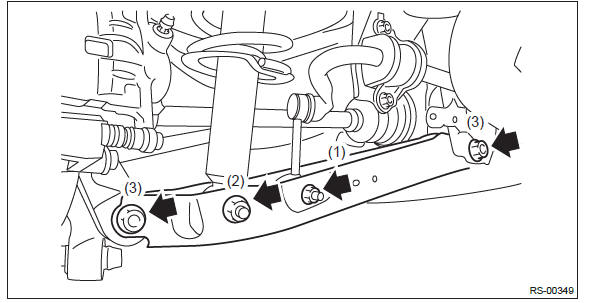
B: INSTALLATION
CAUTION:
- Be sure to use a new self-locking nut.
- Always tighten the bushing in the state where the vehicle is at curb weight and the wheels are in full contact with the ground.
1) Before installation, inspect the following items and replace any faulty part with a new one.
- Visually check the rear lateral link for damage and deformation.
- Visually check the bushing for abnormal cracks, fatigue or damage.
2) Install each part in the reverse order of removal.
Tightening torque:
Rear lateral link: 80 N*m (8.16 kgf-m, 59.0 ft-lb)
Shock absorber: 80 N*m (8.16 kgf-m, 59.0 ft-lb)
Stabilizer link: 33 N*m (3.36 kgf-m, 24.3 ft-lb)
3) Inspect the wheel alignment and adjust if necessary. <Ref. to FS-9, INSPECTION, Wheel Alignment.>
C: DISASSEMBLY
Using the ST, push out the bushing.
PREPARATION TOOL: ST-A & ST-B: INSTALLER & REMOVER (20299AE010)
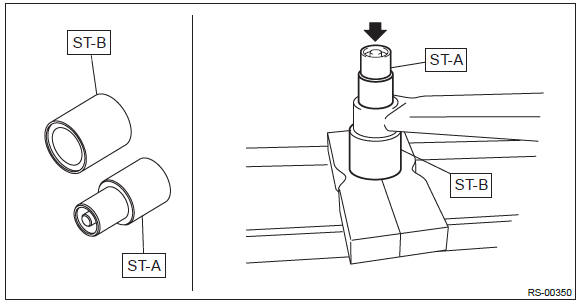
D: ASSEMBLY
1) Before assembly, inspect the following items and replace any faulty part with a new one.
- Visually check the rear lateral link for damage and deformation.
- Visually check the bushing for abnormal cracks, fatigue or damage.
2) Using the ST, press the bushing into place.
PREPARATION TOOL: ST-A & ST-B: INSTALLER & REMOVER (20299AE010)

General Diagnostic Table
A: INSPECTION
1. IMPROPER VEHICLE POSTURE OR IMPROPER WHEEL ARCH HEIGHT

2. POOR RIDE COMFORT
1) Large rebound shock
2) Rocking of the vehicle continues too long after running over bump and hump.
3) Excessive shock in bumping

3. NOISE


